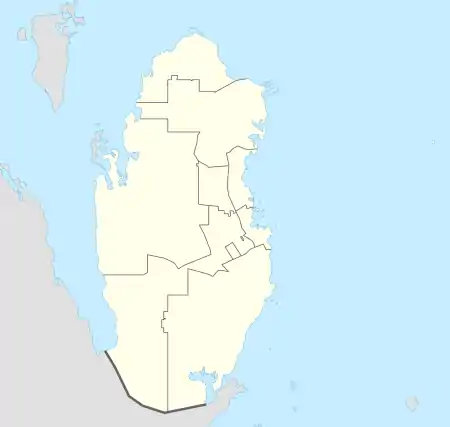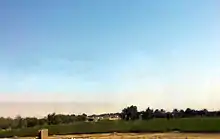Rawdat Al Hamama
Rawdat Al Hamam (Arabic: روضة الحمام, romanized: Rawḑat al Hamam) is a village in the municipality of Al Daayen in Qatar.[2][3] It is located between two major highways: Al Khor Expressway and Al Shamal Road.[4] Government authorities have launched major developments in the village, including a housing subdivision with a target capacity of 30,000 residents.[5]
Rawdat Al Hamam
روضة الحمام | |
|---|---|
Village | |
 Rawdat Al Hamam | |
| Coordinates: 25°26′46″N 51°28′7″E | |
| Country | |
| Municipality | Al Daayen |
| Zone | Zone 70 |
| District no. | 119 |
| Area | |
| • Total | 15.3 km2 (5.9 sq mi) |
Etymology
The first part of its name, 'rawdat', is the Arabic term used for a depression. Hamām is Arabic for dove.[6]
Geography

It is located in the southern section of the municipality, 3 km north of Al Kheesa and about 10 km north of Doha.[4] It has some vegetation in the form of trees and grasses and is used as a farming area.[7] It is also used as a grazing area for camels and sheep.[6]
History
J.G. Lorimer's Gazetteer of the Persian Gulf, written in 1908, has an entry for Rawdat Al Hamam, referring to it simply as "Al Hamāma". He gives its location as 12 miles north of Doha and 2 from the east coast. Few details are offered of it, except that it is a camping ground for Bedouins and has a masonry well which yields brackish water at 2 fathoms deep.[8]
Infrastructure
There are hundreds of residential housing units in the village. Car accidents are common in the area due to a lack of light poles and the narrowness of the roads, some of which are unpaved.[9] In 2017, the government carried out infrastructure works in the village which witnessed improvements made to its roughly 19.5 kilometres (12.1 mi) road system as part of the first stage of construction. In addition to paving several streets, approximately 330 road signs and 790 light poles were put in place. A drainage system of 15 kilometres (9.3 mi) was also installed. The value of contracts handed out for the first phase was QR 345 million.[4]
Developments
Currently, the area is being developed as a major mixed-use center for Al Daayen's southern sector.[10] In particular, the village is undergoing developments to serve the retail and administrative needs of the residents of nearby Al Kheesa.[11] A low-density housing scheme was launched in 2010 and aims at serving up to 30,000 residents.[5]
The Qatar National Master Plan (QNMP) is described as a "spatial representation of the Qatar National Vision 2030".[12] As part of the QNMP's Urban Centre plan, which aims to implement development strategies in 28 central hubs that will serve their surrounding communities, Rawdat Al Hamam has been designated a District Centre, which is the lowest designation.[13]
Rawdat Al Hamam's District Centre is set to be constructed to the immediate east of the housing development launched in 2010. The overall area of the District Centre is relatively large and mostly consists of a lightly-grassed field. It will be a mid-point between Lusail and Umm Salal, and thus public transport and road infrastructure are major aspects of the master plan. Structures that will be erected as part of the plan include a primary boys' school, a primary girls' school, a 12,760 m² public health centre, a large 91,981 m² public park, a youth centre and civil defense facilities.[5]
Historic landmarks
Abandoned farmhouse
There is an abandoned farmhouse in Rawdat Al Hamam which was originally constructed in 1945. Enclosed by walls and facing a large central courtyard, the house is rectangular and measures 22 by 29 m. It has three rooms which are accessible through the courtyard. There are no ornamental features in either the house or compound. The house is considered to be representative of North Arabian architecture during the mid-20th century.[7]
References
- "District Area Map". Ministry of Development Planning and Statistics. Retrieved 1 March 2019.
- "2010 population census" (PDF). Qatar Statistics Authority. Archived from the original (PDF) on 2 April 2015. Retrieved 18 December 2015.
- "Al Daayen Municipality". Ministry of Municipality and Urban Planning. Retrieved 18 December 2015.
- "Rawdat al-Hamama residents briefed on infrastructure works". Gulf Times. 3 October 2017. Retrieved 8 November 2019.
- "Centre Plans and Zoning Regulations" (PDF). Ministry of Municipality and Environment. pp. 199–206. Retrieved 15 November 2019.
- "GIS Portal". Ministry of Municipality and Environment. Retrieved 12 August 2017.
- Jaidah, Ibrahim; Bourennane, Malika (2010). The History of Qatari Architecture 1800-1950. Skira. p. 90. ISBN 978-8861307933.
- "'Gazetteer of the Persian Gulf. Vol. II. Geographical and Statistical. J G Lorimer. 1908' [1520] (1635/2084)". Qatar Digital Library. Retrieved 19 January 2019. This article incorporates text from this source, which is in the public domain.
- "أهالي روضة الحمام يطالبون بتعبيد وإنارة الطرق الداخلية" (in Arabic). Al Sharq. 12 January 2015. Retrieved 12 August 2017.
- "Al Daayen Municipality: Vision and Development Strategy" (PDF). Ministry of Municipality and Environment. December 2017. p. 12. Retrieved 23 May 2018.
- "Al Daayen Municipality: Vision and Development Strategy" (PDF). Ministry of Municipality and Environment. December 2017. p. 16. Retrieved 23 May 2018.
- "About Qatar National Master Plan". Ministry of Municipality and Environment. Retrieved 15 November 2019.
- "About the Centre Plans". Ministry of Municipality and Environment. Retrieved 15 November 2019.